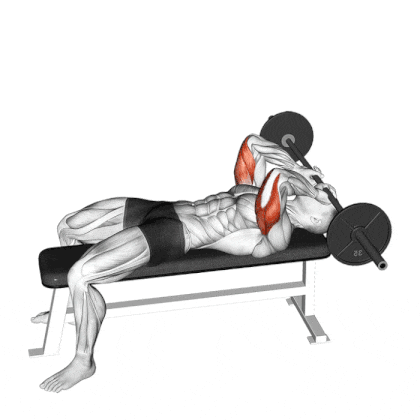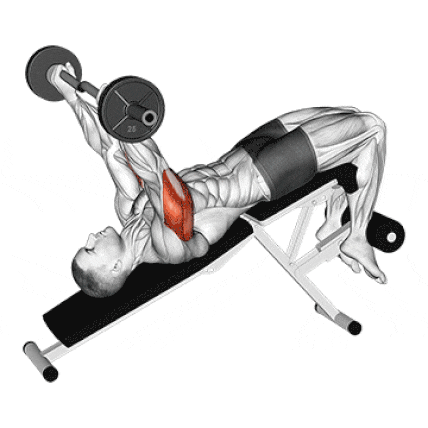Barbell skull crushers, also known as lying triceps extensions, are isolation exercises that work the triceps brachii muscle. The term “skull crusher” derives from the exercise’s fundamental mechanics of lowering the weight toward the skull from an elevated position.
Barbell skull crushers are a popular type of skull crusher among gymgoers and bodybuilders.
However, there are many other ways to do barbell skull crushers, such as altering the bench position to either incline or decline.
- EZ Bar Skull Crusher
- Incline Barbell Skull Crusher
- Decline Barbell Skull Crusher

Barbell Skull Crusher Muscles Worked
- Barbell skull crushers primarily target the triceps brachii, with a particular emphasis on the long-head tricep. The exercise also significantly engages the medial and lateral heads of the triceps.
- Synergist and Stabilizer Muscles: The pectoralis major, anterior deltoids, Lats, forearm muscles (like the brachioradialis) and Core muscles.
- Antagonist Muscles: the biceps brachii and brachialis.

How To Do Barbell Skull Crusher
- Lie down on a flat bench with your feet firmly planted on the ground.
- Make sure the barbell is loaded with the appropriate weight.
- Ensure your head, upper back, and buttocks are in contact with the bench.
- Grasp the barbell with an overhand grip (palms facing down) slightly narrower than shoulder-width apart.
- Make sure your upper arms are perpendicular to the floor.
- Slowly lower the barbell towards your forehead by bending your elbows.
- Lower the barbell until it is just above your forehead or until you feel a stretch in your triceps.
- Once you reach the bottom position, pause for a moment.
- Then, engage your triceps and extend your arms to lift the barbell back to the starting position.
- Complete the 3-4 sets of 8–12 repetitions.
Form and Tips
- Avoid lowering the weight too close to your face or forehead. This can put too much strain on the elbows and increase the risk of getting hurt.
- Keep your wrists neutral throughout the exercise to minimize joint strain.
- You should do the whole movement slowly and carefully, especially when the weight is moving down.
- Don’t let the barbell fall too quickly or bounce off.
- Exhale during the concentric phase (when lifting the barbell) and inhale during the eccentric phase (when lowering the barbell).
- Limit shoulder movement as much as possible. Keep your shoulders and upper arms fixed. The movement should be mainly done by the elbows.
- Keep your elbows close to your head and pointing upward.
- Avoid allowing your elbows to flare out to the sides or drift forward.
- Don’t lock your elbows at the top of the movement. This can put stress on your elbows and cause injury.
- Pause for a moment at the bottom of the movement. This will help stretch the triceps and improve the workout.
- Start light, add weight gradually, and always keep the movement under full control.
- Research has shown that higher-intensity exercises with moderate repetitions and sets build muscle by recruiting a greater number of muscle fibers.
| Goal | Sets | Reps | Rest Between Sets |
|---|---|---|---|
| Muscle Growth | 3 to 4 sets | 8 to 12 reps | 60 to 90 seconds |
| Endurance | 3 to 4 sets | 15 to 20 reps | 30 to 45 seconds |

Barbell Skull Crusher Variations
You can perform many barbell skull crusher variations by changing the bench and grip positions. You can also do it in different ways that suit your fitness level.
- If you’re new to doing skull crushers, you can make it easier by using lighter weights.
- Try incline and decline barbell skull crushers for a more advanced way to engage different muscle groups in the triceps.
1. Incline Barbell Skull Crusher
The incline skull crusher helps to build muscle and strength in all three tricep heads. If you have shoulder pain from the traditional barbell skull crusher, the incline variation can help. The angle of the incline bench reduces the stress placed on the shoulder joints.
Adding incline skull crushers to your tricep workout routine can help you strengthen and overcome plateaus.

How To Do
- Set an incline bench at around 30-45 degrees.
- Take an EZ Bar and lie down on a bench with your face facing up and your feet on the floor.
- Extend your arms over your shoulders with your palms facing up.
- Then, slowly lower the weight towards your forehead by bending your elbows.
- Hold this position for a count, and then raise your arms back up to the starting position with a controlled motion.
- Do not use excessively heavyweight, as this is dangerous for your elbows.
2. Decline Barbell Skull Crusher
The decline skull crusher can be easier on your lower back than the flat and incline versions. The decline position naturally encourages a more neutral spine alignment.
The decline angle enhances the stretch on the triceps during the eccentric phase and allows for a deeper contraction during the concentric phase. This increased range of motion can lead to greater muscle activation and development.

How To Do
- Grab a barbell and lie against a decline bench with your feet firmly on pads.
- Extend your arms over your shoulders with your palms facing up, and then slowly lower the barbell behind your head by bending your elbows.
- Hold this position for a count. Then, in a controlled motion, raise your arms back up to the starting position.
FAQs
Are skull crushers for beginners?
Skull crushers are not generally recommended for beginners. They are challenging exercises that can put a lot of stress on the triceps and shoulders. If you are a beginner, it is better to start with other exercises that are less demanding, such as triceps pushdowns or dumbbell kickbacks.
Are skull crushers safe?
Skull crushers are safe when performed correctly and at the right weight. However, if you already have shoulder, elbow, or wrist issues, you should exercise caution and consult with a fitness professional before starting.
References
- Boehler B, Porcari JP, Kline D, Hendrix R, Foster C, Anders M. ACE-sponsored research: Best triceps exercises. American Council on Exercise.
- Borges E, Mezêncio B, Pinho J, Soncin R, Barbosa J. Resistance training acute session: pectoralis major, latissimus dorsi and triceps brachii electromyographic activity. J Phys Ed Sport. 2018;2018(02):648-653. doi:10.7752/jpes.2018.02095
- Alves D, Matta T, Oliveira L. Effect of shoulder position on triceps brachii heads activity in dumbbell elbow extension exercises. J Spors Med Phys Fitn. 2017;58(9):1247-52. doi:10.23736/s0022-4707.17.06849-9
- Shuttlewood K, Beazley J, Smith CD. Distal triceps injuries (Including snapping triceps): A systematic review of the literature. World J Orthop. 2017;8(6):507-513. doi:10.5312/wjo.v8.i6.507
- American Council on Exercise. ACE Study Identifies Best Triceps Exercises.

Manish is a NASM-certified fitness and nutrition coach with over 10 years of experience in weight lifting and fat loss fitness coaching. He specializes in gym-based training and has a lot of knowledge about exercise, lifting technique, biomechanics, and more.
Through “Fit Life Regime,” he generously shares the insights he’s gained over a decade in the field. His goal is to equip others with the knowledge to start their own fitness journey.
